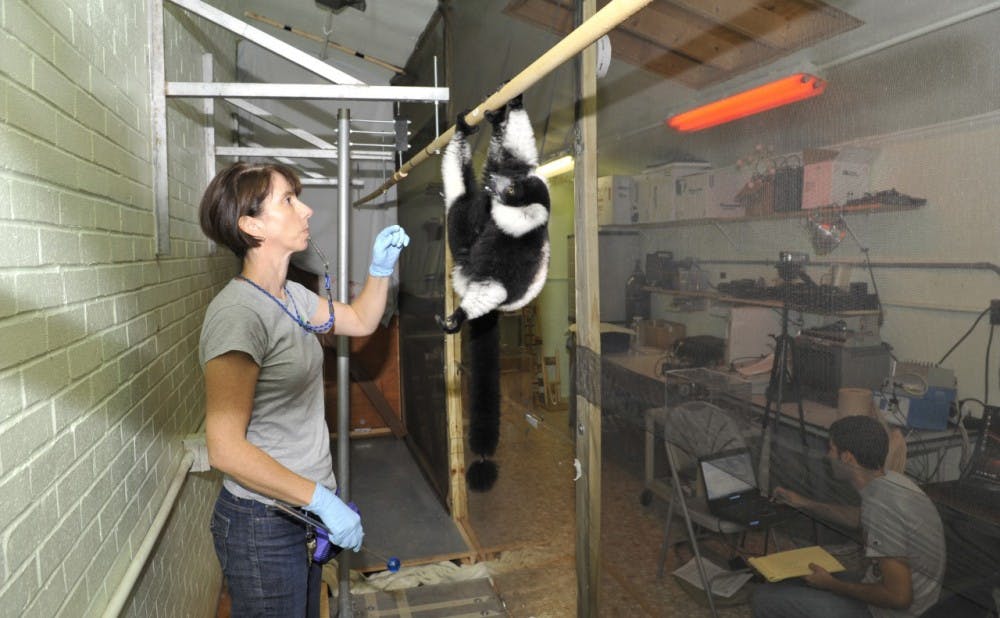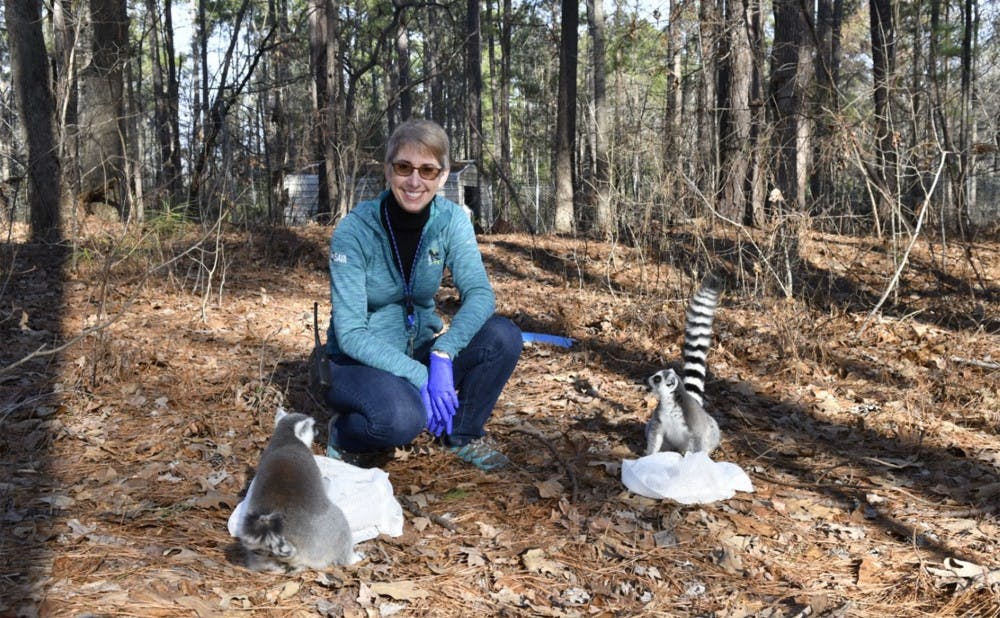Recess has ended, and it’s snack time at lemur preschool.
Meg Dye, curator of behavioral management, blows on her high-pitched whistle to ask Sophia, Randy, Nemesis and Narcissa to come over for bite-sized golden apple chunks. Sophia springs onto the cage door to grab her first portion from Dye. Sophia guides the tiny apple into her mouth and gnaws away with smacking lips.
As Dye explains, snack time is basic training for this ring-tailed lemur crew. Like at a preschool, she wants the lemurs to learn to take turns and focus on the teacher.
Dye has been at the Duke Lemur Center for about 11 years, seven as a full-time staff member. She first came to the DLC on a consulting stint to teach staff about positive reinforcement techniques. Having worked primarily with dolphins, sea otters and other marine animals, she didn’t know much about lemurs.
“One of my consulting contracts was the Duke Lemur Center,” Dye said. “Honestly, I fell in love with this place.”
After coming to the DLC, she stopped taking contracts from other wildlife centers. She devoted her days to the DLC’s approximately 250 lemurs, who she almost blends in with. Wide-eyed, Dye wears short grey hair and a black turtleneck. She pulls back her neck and torso, imitating a wary lemur preparing to retreat. She smudges her temple and cheeks mimicking Grendel, an aye-aye participating in early morning research with pretty bad bed head. She squeaks like a blue-eyed black lemur indulging in cantaloupe.
But unlike her effervescent lemur friends, Dye is naturally composed and calculated.
“Working with animals on a daily basis definitely takes a certain temperament,” Dye said. “It’s a lot of patience and a lot of love for what you are doing.”
Pick me!
Next, Dye slides into a quiet, dark room tinted with red light and walled with spacious black lemur cages, or “condos.” She pulls out a syringe filled with pineapple juice, rattles it between the cage links and blows a peep from her whistle. Mushmelon, a particularly cheery lemur, wakes up. Dye beckons her into an approximately two-foot wide box that she attached to the cage.
Dye and two other researchers are ready to run a memory game with Mushmelon as part of the DLC’s non-invasive research studying Alzheimer’s disease. Mouse lemurs are perfect for this research—their naturally short life spans allow for Alzheimer’s research at just about seven years old. Unlike actual mice, mouse lemurs are prosimian primates, an “ancestral root” to humans.
“Because they are a closer genetic match to humans than mice or rats are, researchers at the Duke Lemur Center hope that non-invasive research on these tiny primate cousins will help humans too,” according to the DLC website.
Just like with clinical research, volunteerism is fundamental to studying Alzheimer’s through lemurs.
“We use training to teach the animals to voluntarily participate in research,” Dye said. “It changes the conversation from, ‘You will get on this scale,’ or, ‘You will get in this kennel,’ to, ‘Will you please go into this kennel? Will you please get on this scale?’”
Lured with pineapple juice, Mushmelon thinks this is a game. From a grainy computer screen, Dye watches her dash across the inside of the black box toward the touch screen. When Mushmelon touches the screen with a striped pattern on it, pineapple juice automatically dispenses in a small bowl behind her. Skitter! Tap! Munch. Skitter! Tap!
When Mushmelon gets tired of playing, Dye says she can choose to go back home.

For Dye, seeing lemurs participate enthusiastically is one of the best parts of the job. When animals are relaxed, research data are more accurate. It’s a boon for the lemur and the researchers.
“I get excited that we can teach these animals how to answer research questions,” Dye said. “If they want to come over and participate, that’s great. But they don’t have to.”
She uses positive reinforcement training to encourage lemurs to volunteer, recycling these techniques from working with sea otters at the Monterey Bay Aquarium and a variety of marine mammals at Chicago’s Shedd Aquarium.
Positive reinforcement
Dye opens a closet and pulls out two white nets. Walking through a lemur family’s cage door, she places the nets on the ground and a cantaloupe chunk on top of it.
“Can you please walk on the net?” Dye asks the matriarchal lemur Sprite.
Sprite doesn’t get on the net right away, but Dye encourages her over with a bit more fruit. Dye is teaching Sprite and her family to walk in the nets so that the DLC can administer vaccines and other medications to the ring-tailed lemurs. Animal comfort is Dye’s chief priority.
“Animal welfare is always from the perspective of the animal, not from our perspective. What is in the animal’s best interest?” Dye says.
Excitedly, Dye says today is Sprite’s daughter Lulu’s first time stepping on the net. Lulu munches proudly on her cantaloupe and then pronounces she’s done by dropping leftover fruit on the ground.
Dye’s lemur preschool hasn’t learned about clean-up time quite yet.
Get The Chronicle straight to your inbox
Signup for our weekly newsletter. Cancel at any time.

